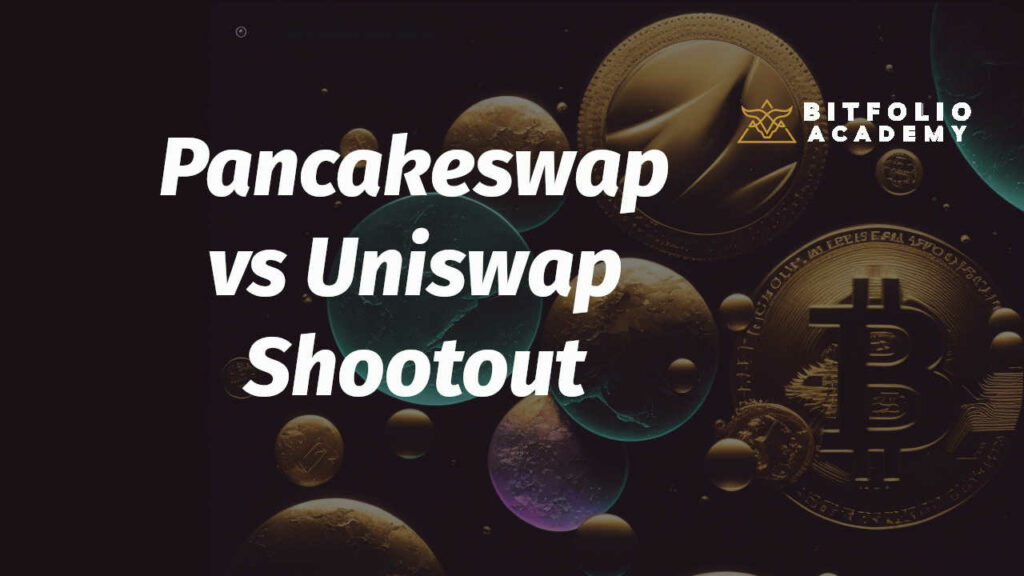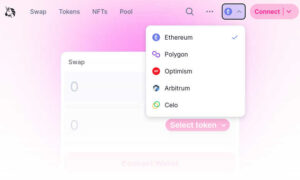
Uniswap and Pancakeswap: What’s the Difference, Which one to choose?
If you’re familiar with the world of cryptocurrency, you have likely heard about Uniswap.org and Pancakeswap Finance, two popular decentralized exchanges (DEXs). Here’s a breakdown of what each platform offers and their differences.
What is Uniswap and Pancakeswap?
Uniswap is a decentralized exchange, first built on the Ethereum blockchain. It allows users to trade Ethereum-based tokens without a central authority or middleman. Instead, Uniswap uses an automated market-making (AMM) system, where liquidity providers add funds to pools, and traders can trade against these pools.
In early February of 2023, Uniswap DAO voted to port Uniswap v3 to the BNB Smart Chain (BSC). So, now, Uniswap v3 will live on the Ethereum blockchain and on BNB Smart Chain.
Pancakeswap, on the other hand, is a decentralized exchange built on the BNB Smart Chain (or Binance Smart Chain or BSC). It is a fork of Uniswap v2 and offers similar functionalities, including an AMM system, liquidity pools, yield farming and an NFT marketplace. CAKE is the native coin or token, which is used for various purposes on the platform.
What is a Liquidity Provider?
A liquidity provider (LP) is someone who adds liquidity to a trading pair by depositing an equal value of two tokens (e.g. BNB and USDT) into a liquidity pool. Liquidity providers earn a portion of the trading fees generated by that pool in proportion to their share of the total liquidity in the pool.
When a trader wants to make a trade on Pancakeswap (or Uniswap), they do so by swapping one token for another in the liquidity pool. The price of the token is determined by the ratio of tokens in the pool. When a trader swaps tokens, they pay a swap fee, which is split among liquidity providers according to their share of the pool.
By providing liquidity, LPs help to ensure that the trading pair has enough liquidity for traders to buy and sell tokens without drastically affecting the price. However, providing liquidity also comes with risks, such as impermanent loss, which is the difference in the value of the tokens in the pool compared to their value when they were deposited.
Differences between the two DEXs
Here are some of the main differences between Uniswap and Pancakeswap:
- Blockchain: Uniswap operates on the Ethereum blockchain and also soon to be on the BNB Smart Chain, while Pancakeswap operates only on the BNB Smart Chain.
- Transaction fees: Uniswap’s transaction fees are notoriously high due to network congestion on the Ethereum blockchain. In contrast, Pancakeswap’s transaction fees are relatively low. However, when using Uniswap v3 on the BNB Smart Chain, the fees should also be relatively low.
- Tokens available: Uniswap could potentially offer a wider range of tokens by offer both ERC-20 tokens or Ethereum tokens and soon BEP-20 tokens or BSC tokens. Pancakeswap only offers BEP-20 tokens.
- Interface: Uniswap has a more straightforward interface, offering fewer features, while Pancakeswap has more bells and whistles, including yield farming, lottery systems, an NFT marketplace and more.
Which DEX to choose?
The answer to this question depends on your needs and preferences. Here are some factors to consider when choosing between Uniswap and Pancakeswap:
- Token availability: If you’re looking to trade a specific token that is only available on one of the platforms, that may influence your choice. When it launches on BSC, Uniswap will likely not have as many BEP-20 tokens as Pancakeswap.
- Interface: If you prefer a more straightforward interface less value-added features like a lottery, Uniswap may be the better choice.
- Uniswap v3 is a newer and improved version of Uniswap. Uniswap v3 is that it’s more efficient than v2. Pancakeswap is based on Uniswap v2. v3 is more accurate. This means that when you trade on v3, you get a better price (less slippage) or a better exchange rate.
- Uniswap v3 has a flexible fee structure, which means that people who provide money to the market (called liquidity providers) can earn more money or higher fees (than on Pancakeswap).
Overall, both Uniswap and Pancakeswap have their strengths and weaknesses.
Uniswap: A major player in DeFi
Uniswap is a decentralized exchange (DEX) that was launched in 2018. Uniswap quickly gained popularity due to its unique approach to liquidity pools and its automated market-making (AMM) mechanism. Here are some key features and benefits of using Uniswap:
Overview of Uniswap
- Uniswap is a decentralized exchange that allows users to trade ERC-20 and BEP-20 tokens without the need for intermediaries such as centralized exchanges.
- Uniswap uses an automated market maker (AMM) mechanism to determine the price of tokens based on the ratio of their supply in the Uniswap liquidity pool.
- The platform is open-source, transparent, and permissionless, allowing anyone to create a new token pair or add liquidity to existing pools.
Features and benefits of Uniswap
- Uniswap provides users with high liquidity and low slippage due (espcially in v3) to its automated market maker (AMM) mechanism.
- Users can earn fees by providing liquidity to Uniswap pools, and they receive a portion of the trading fees generated by the pool proportional to their share of the liquidity.
- Uniswap has a user-friendly interface and supports a wide range of ERC-20 and BEP-20 tokens, making it easy for anyone to use.
Uniswap App Advantages
Some of the main advantages of using Uniswap include:
Liquidity
Uniswap is known for its high liquidity, thanks to its automated market-making (AMM) system that provides a constant flow of liquidity without the need for centralized intermediaries. This means that traders can easily buy or sell tokens without having to worry about low liquidity or market volatility.
Decentralization
- Uniswap is fully decentralized, which means that it is not owned or controlled by any centralized authority or company. This ensures that users have full control over their assets and that there is no single point of failure that could compromise the security of the platform.
- Uniswap also inherits the decentralization and security of Ethereum.
Efficiency
- Uniswap has a simple and intuitive user interface, which makes it easy for traders of all levels to use.
- Transactions on Uniswap are also efficient, thanks to its automated pricing and trading algorithms.
UNI token
- UNI is the native token of Uniswap, which provides holders with the ability to vote on changes to the Uniswap platform.
- As Uniswap continues to grow in popularity, the demand for UNI is likely to increase, which could result in a rise in its price.
In summary, Uniswap offers numerous advantages to traders and investors, such as high liquidity, decentralization, efficiency, and the potential for token price appreciation through UNI ownership.
Uniswap Disadvantages
Uniswap is a popular decentralized exchange (DEX) that has revolutionized the way traders can buy and sell cryptocurrencies. However, there are some disadvantages to using Uniswap that traders should be aware of:
1. High transaction fees on Ethereum
The Ethereum blockchain is notorious for high gas fees for transactions. The gas fees can sometimes be very high, especially during periods of high network congestion, making it difficult for smaller traders to participate.
2. Limited token offerings
Uniswap’s token offerings may not be as robust as Pancakeswap. But, the verdict is still out on this one. When Uniswap v3 launches on BSC, the combined trading pairs on Ethereum and BSC could potentially be greater than the trading pairs than Pancakeswap.
3. No order book
Both Pancakeswap and Uniswap use an automated market maker (AMM) system instead of an order book, which can be confusing for some traders. This system allows users to trade against a pool of liquidity instead of other traders, which can lead to less accurate price discovery.
4. Front-running
Both Pancakeswap and Uniswap’s AMM system can be vulnerable to front-running, which is when traders use their knowledge of pending transactions to their advantage. This can lead to traders getting a worse price on their trades.
Overall, while Uniswap has many advantages as a DEX, there are also some drawbacks that traders should consider before using it. It is important for traders to understand the differences between a centralized exchange with an order book and a decentralized exchange with an automated market maker
UNI token and its price prediction
- UNI is the native token of Uniswap, and it is used to govern the protocol through community-led governance proposals.
- The token has a maximum supply of 1 billion, with a circulating supply of around 762 million as of March of 2023.
- According to some price prediction models, the UNI token is expected to continue its upward trajectory in the coming years due to the growing popularity of decentralized finance (DeFi) and the increasing adoption of Uniswap.
In summary, Uniswap is a DEX that has become one of the most popular platforms in the DeFi space due to its unique features and benefits. Its AMM mechanism, high liquidity, and low fees make it a compelling choice for anyone looking to trade ERC-20 or BEP-20 tokens.
Pancakeswap: The Unicorn of Binance Chain
Pancakeswap is a DEX built on the BNB Smart Chain (or BSC). It was launched in September 2020 and quickly gained popularity among crypto enthusiasts. Just like Uniswap, Pancakeswap allows users to trade cryptocurrencies in a decentralized and trustless manner, while also offering liquidity pools, yield farming, staking features and more.
Overview of Pancakeswap
Pancakeswap operates similarly to Uniswap v2, but with a few key differences. In the past, Pancakeswap had lower transaction fees and faster confirmation times compared to Uniswap on Ethereum, thanks to the BNB Smart Chain’s high-speed network. Due to the lower transaction fees on BSC, many preferred to use BSC rather than Ethereum. And, Pancake swap is the #1 DEX on BSC. Additionally, Pancakeswap has implemented various features to enhance the user experience and provide more opportunities for profit, such as lotteries and non-fungible token (NFT) collections.
Since Uniswap v3 is also migrating to BNB Smart Chain, Uniswap will also benefit from lower transaction fees and faster confirmation times on BSC.
Features and Benefits of Pancakeswap
Some of the key features and benefits of Pancakeswap include:
- Low transaction fees on BSC
- Fast confirmation times on BSC
- High liquidity in Pancakeswap liquidity pools
- Yield farming and staking opportunities
- Lotteries and NFT collections
- User-friendly interface
- High-quality security features
Pancakeswap App Advantages
Highly Efficient and Fast Transactions
Pancakeswap offers fast transactions and low gas fees. It is built on the BNB Chain (or BSC) which has faster transaction times and lower gas fees than Ethereum.
Low Transaction Fees
The BNB Smart Chain offers significantly lower transaction fees compared to Ethereum, making it more cost-effective for users to perform transactions. Pancakeswap’s fees are low due to its use of the BNB Smart Chain (or BSC). Uniswap will also benefit from lower fees on the BNB Smart Chain.
Single-Token Staking
Pancakeswap offers single token staking (called Pools). Uniswap does not offer single-token staking. So, Pancakeswap offers users with more rewards for holding and staking their tokens on the platform. One can earn yield by being a liquidity provider and also by single-token staking. The UNI token cannot be staked on Uniswap to earn yield, but third parties do offer UNI staking.
Built-In Lottery and Gaming Features
Pancakeswap offers built-in lottery and gaming features which are not available on Uniswap. These features provide users with additional opportunities to earn rewards and engage with the platform.
More Trading Pairs
Pancakeswap offers a wider range of trading pairs compared to Uniswap, providing users with more options for trading and liquidity provision.
Perpetual Futures
Pancakeswap offers perpetual futures trading (there is not any expiration date on the futures contract). Perpetual futures trading with 25x leverage is a type of trading that allows people to make bets on the future price of cryptocurrency assets, with the ability to borrow money to amplify their gains or losses. “25x leverage” means that traders can borrow up to 25 times the amount of money they have in their account to make trades. Needless to say, this can be very risky and can lead to significant losses if the market moves against the trader.
Overall, Pancakeswap’s advantages make it an attractive platform for users looking for a cost-effective and efficient decentralized exchange experience.
Pancakeswap Disadvantages
1. Centralization Concerns
Pancakeswap is built on the BNB Smart Chain, which is a centralized blockchain network owned in part by Binance. At the time of writing, there are only 57 total validators on BNB Chain. This has raised concerns about centralization, as it is not fully decentralized like Ethereum (with over 500,000 validators).
2. Less Liquidity
Pancakeswap is still relatively new compared to Uniswap, and it has less liquidity as a result. Uniswap also has less trading pairs, so they concentrate liquidity in fewer pairs. Less liqudity means that users may experience slippage when trading large amounts, especially with small-cap coins or tokens.
3. Security Concerns
Pancakeswap has been subject to a number of security concerns and hacks, which has led to concerns among users about the platform’s security and safety. However, the Pancakeswap team has taken steps to address these issues and improve security on the platform.
CAKE Token and its Price Prediction
The native token of Pancakeswap is called CAKE, and it is used for various purposes on the platform, including governance, providing liquidity in the pools, and earning rewards. CAKE has been up and down since its launch in September 2020. As of March 2023, CAKE price is around $4 per token, with a market capitalization of $760,000. Some analysts predict that CAKE will rise in value as the popularity of Pancakeswap grows.
Where to buy Pancakeswap CAKE
One can buy CAKE on Pancakeswap as well as on Binance and other exchanges. One can also earn CAKE by providing liquidity.
Total Value Locked (TVL) and Market Cap Comparison
Comparison of TVL and market cap of Uniswap and Pancakeswap
- As of this writing, the total value locked (TVL) of Uniswap stands at around $4 billion, while Pancakeswap’s TVL is around $2.5 billion.
- Uniswap (or UNI) currently has a market cap of approximately $4.9 billion, while Pancakeswap (or CAKE) has a market cap of around $760,000.
- Pancakeswap has gained significant attention due to its popularity and its wide range of trading pairs.
- Uniswap, on the other hand, has been the dominant DEX in the DeFi space and has a strong community following.
Analysis of TVL and market cap data
- Uniswap’s strong community following and reputation in the DeFi space may contribute to its higher market cap and higher TVL than Pancakeswap.
- Both Uniswap and Pancakeswap have demonstrated strong growth and are among the leading DEXs in the cryptocurrency space.
- While Ethereum has 60% of the DeFi market, BSC has 10%. Uniswap has $3.5 billion in TVL. Pancakeswap has $2.4 billion in TVL.
- Pancakeswap has been wildly popular in terms of the number of users. Pancakeswap: 130,000 users per day. Uniswap: 90,000 users per day.
UNI token vs CAKE token
- Comparison of UNI and CAKE tokens
- Analysis of token features and price trends
Both UNI and CAKE are utility tokens native to their respective decentralized exchanges, Uniswap and Pancakeswap. While both tokens have similarities, they also have some notable differences.
Comparing UNI and CAKE tokens:
- UNI has a maximum total supply of 1 billion tokens, while CAKE has a maximum total supply of 750 million tokens.
- Both UNI and CAKE were created in September 2020.
- UNI is used for governance and fee-sharing on Uniswap on Uniswap, while CAKE is used for liquidity providing, yield farming, staking and for governance on Pancakeswap.
- Both tokens have experienced price fluctuations, but UNI has generally maintained a higher price than CAKE.
Analysis of token features and price trends:
- UNI’s governance and fee-sharing features have contributed to its higher price relative to CAKE.
- CAKE’s liquidity providing, yield farming, and staking features have made it more attractive to traders looking for ways to earn rewards in the Pancakeswap ecosystem.
- Both tokens have been affected by market conditions.
User Interface
When it comes to choosing a decentralized exchange (DEX) to trade cryptocurrencies, user experience plays an important role. Uniswap has a simple and minimalistic interface that is easy to navigate. The platform is designed for a seamless user experience, and the interface is organized to help users find what they need quickly. Pancakeswap, on the other hand, has a more complex interface due to the fact that it has more features and it may take some time to navigate. For example, the “Win” section of Pancakeswap has four different sections.
Fees
Uniswap charges a 0.3% fee for every swap (or every transaction), which is the industry standard for DEXs. Pancakeswap, on the other hand, charges a lower fee of 0.2% for each transaction.
Overall Experience
Overall, Uniswap provides a smoother, more streamlined user experience, while Pancakeswap has a wider range of features. Which platform to choose ultimately depends on the user’s specific needs and preferences. In conclusion, both Uniswap and Pancakeswap are excellent decentralized exchanges, each with its own strengths and weaknesses. Ultimately, the decision to use one over the other depends on the user’s individual preferences and needs.
Uniswap vs Pancakeswap Trading Pairs and NFTs
Uniswap and Pancakeswap offer different coins and trading pairs. Here’s a comparison of the two decentralized exchanges:
Uniswap
Uniswap is a decentralized exchange, primarily focused on the Ethereum blockchain (but soon to be on BSC, also). It offers a wide range of Ethereum-based tokens (and soon BEP-20 tokens, too), including stablecoins like USDT, USDC, DAI, and others. Some of the notable coins offered on Uniswap include:
- ETH
- WBTC
- UNI
- LINK
- SNX
- COMP
- AAVE
- YFI
Uniswap has high liquidity and trading volume, making it an attractive option for traders looking to buy and sell tokens at a good price (with little slippage).
Pancakeswap
Pancakeswap is a decentralized exchange on the BNB Smart Chain (BSC). It offers a variety of BSC-based tokens (or BEP-20 tokens), including stablecoins like USDT, USDC, and DAI. Some of the notable coins offered on Pancakeswap include:
- BNB
- BTCB
- ETH
- CAKE
- USDC
- USDT
- DAI
Pancakeswap has decent liquidity and trading volume. However, sometimes a lack of liquidity can lead to experience high slippage during trades. Slippage refers to the difference between the expected price of a trade and the actual price at which the trade is executed. High slippage occurs when this difference is significant, which can happen when there is low liquidity in the market.
Non-fungible tokens (NFTs)
In November of 2022, Uniswap expanded into the NFT ecosystem by launching an aggregator to bring together multiple marketplace listings into one interface. This facilitates better prices, faster indexing, and more efficient execution. Uniswap’s aggregator also offers gas savings compared to other NFT aggregators when purchasing across marketplaces. Additionally, Uniswap is committed to being trustless and transparent, and has open-sourced all of their front-end code.
The Pancakeswap NFT marketplace allows users to buy and sell NFTs on the BNB Smart Chain. With 3.5 million users over the past 30 days, it is ranked as the top decentralized dApp by user count, and its NFT market is expected to see a serious increase in volume. Currently, the marketplace saw 2,000 traders exchange a cumulative volume of $330,000 over the last week. That is a small NFT volume compared to OpenSea and to Blur.
On the Pancakeswap NFT marketplace, all collections are verified, so there is no need to worry about scams or rug pulls. To buy an NFT, users need to browse the available collections, choose what they want to buy, and select the NFT they want to purchase.
Analysis
Pancakeswap is a port of Uniswap v2. In other words, Pancakeswap code is based on Uniswap v2. But, Pancakeswap launched on BSC, and Uniswap lived on Ethereum. In the past, Uniswap catered to Ethereum, and Pancakeswap catered to BSC. But, Uniswap has been aggressively expanding into other blockchains.
Uniswap v3 was released in 2021, and it introduced new features and improvements to the platform. One of the key differences between Uniswap v3 and v2 is that it allows liquidity providers to concentrate their liquidity within a specific price range, as opposed to being spread out across the entire price range like in Uniswap v2. This feature is known as concentrated liquidity, and it allows for more efficient use of capital and better pricing for traders. Uniswap v3 also introduced the concept of multiple fee tiers, which allows liquidity providers to choose a fee tier that suits their risk tolerance and investment goals.
Concentrated liquidity is a feature that differentiates Uniswap v3 from Pancakeswap, which is based on Uniswap v2. When Uniswap v3 launches on BSC, many users may prefer Uniswap v3 over Pancakeswap due to trading with low slippage. Concentrated liquidity is attractive for both liquidity providers and for traders.
In general, Uniswap offers ERC-20 coins on Ethereum and BEP-20 tokens on BSC. And, traders will choose the platform that offers the coins and pairs they are interested in trading. Furthermore, since Uniswap has been around for longer, it has more liquidity and trading volume. But, Pancakeswap has been growing rapidly, and it has features that are not offered by Uniswap, namely, a trading competition, a prediction game, a Pancakeswap lottery and so on.
Pancakeswap or Uniswap, What’s the Final Verdict?
After analyzing the key features and data of both Uniswap and Pancakeswap, the following is a summary of the comparison and our final recommendation:
- Uniswap is a popular decentralized exchange built on Ethereum and on the BSC, while Pancakeswap is a decentralized exchange built on the BSC.
- Uniswap has a larger TVL and a larger market cap than Pancakeswap, and offers a lot of liquidity with little slippage.
- Pancakeswap offers lower fees for trading.
- Pancakeswap offers single token staking (called “Pools”). Uniswap does not offer this feature.
- Pancakeswap has a perpetual futures market with up to 25x leverage. Uniswap does not offer this feature.
- Pancakeswap has a trading competition, a prediction game and a lottery. Uniswap does not offer these features.
- Both platforms have their native tokens, UNI for Uniswap and CAKE for Pancakeswap, which have seen significant price growth in recent years.
- Uniswap is an NFT aggregator, while Pancakeswap is an NFT marketplace.
- Uniswap has a more streamlined UI/UX design, while Pancakeswap has many more features.
In conclusion, while both Uniswap and Pancakeswap have their unique advantages and disadvantages. I recommend Uniswap for users who prioritize liquidity and who are primarily doing swaps. Pancakeswap is more suitable for users who prioritize lower fees, trading competitions, lotteries, and futures trading. Regardless of the choice, both platforms offer a secure and efficient way to trade cryptocurrency.

About the Author
David Anderson is a seasoned cryptocurrency expert with over a decade of experience in the industry. As a systems and software engineer, David’s journey into the world of cryptocurrency began when he discovered a hacker mining Worldcoin on one of his servers in 2013. Since then, he has been actively involved in the mining, trading, and investing of digital assets, and has coached many others in the field. David’s passion for technology and his desire to get in early on technologies that will impact the future led him to become a certified Blockchain Solution Architect in 2021. Join David in the Bitfolio Academy Coaching Community and learn from his wealth of knowledge and experience in the exciting world of cryptocurrency investing. For classes or coaching, contact him via his website, https://en.bitfolio.biz
FAQ
Is PancakeSwap safe to use?
The Decentralized Exchange has been around since late 2020. So, it is has survived the test of time. Additionally, PancakeSwap has implemented several security measures to help protect user funds and prevent malicious attacks. These include audits of the platform’s code by third-party security firms, bug bounties for identifying vulnerabilities, and a multi-signature system for transactions that require approval from multiple parties.
PancakeSwap also offers insurance coverage through a partnership with Nexus Mutual, which provides protection against smart contract failures and other risks.
If you are concerned about rug pulls and scams in Defi, I encourage you to download my free PDF guide on How to Avoid Rug Pulls and Scams in DeFi.
Is PancakeSwap easy to sell?
Yes, there is a lot of liquidity for the CAKE token on Pancakeswap. So, you can easily buy and sell it there. You can also buy and sell CAKE on Binance. Many hold CAKE so that they can stake it in the Syrup Pool to earn staking rewards.


